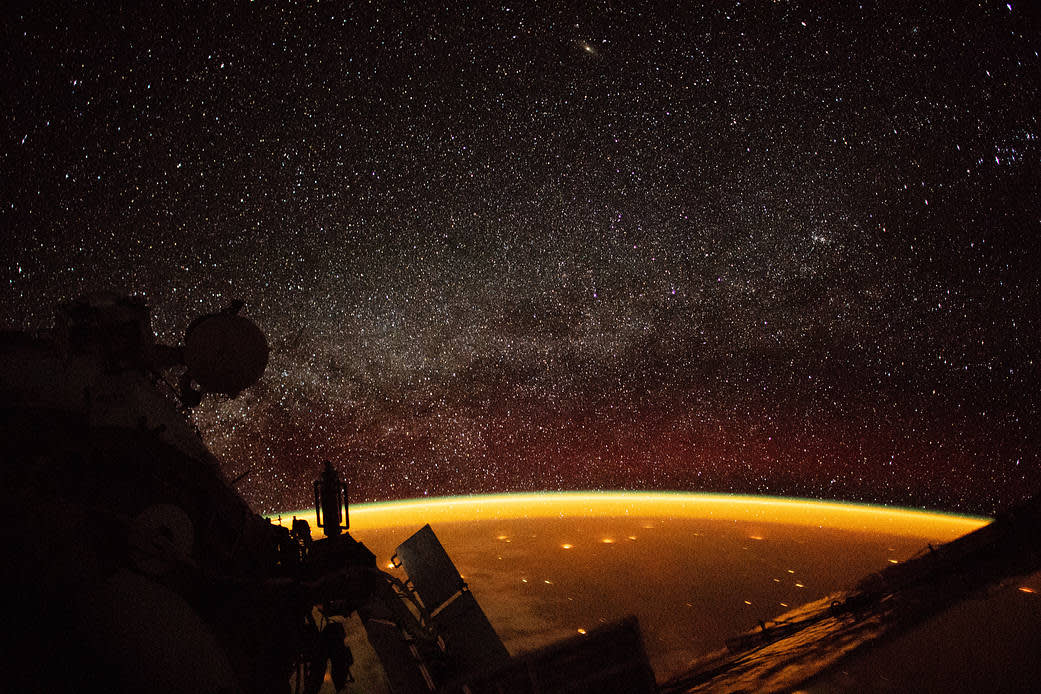Next Launch:
Calculating...Supercluster + Dropbox

Supercluster is made possible, and currently broadcasts live to the cosmos, in part through a partnership with Dropbox.
For years Supercluster was only a dream project, hatched by a dedicated team of space enthusiasts at A24 and GrandArmy, who felt there must be a better way to tell amazing space stories.
Dropbox makes cloud collaboration solutions that give the world’s most creative teams the freedom to work the way they want. When Dropbox learned about the creative collaborations behind Supercluster, they jumped at the opportunity to help.
Together with Dropbox’s support and products, the Supercluster dream became a reality.
We believe Space is For Everyone.
Space is humanity’s greatest story.
We’re here to tell it.
Sponsored by Dropbox
Weekends in Space
Just like us mere Earthlings, Astronauts work regular hours, and when the weekend rolls around, it's time to unwind.
April 2, 2021
article
Tracking Traffic at the International Space Station
Track every spacecraft currently docked to the International Space Station, arrival and departure times, current crew, location in orbit, and ongoing experiments.
March 11, 2021
interactive
Citizen Scientists Help Find Rare Black Holes
Spiral Graph is a citizen science project hunting distant spiral galaxies for a mysterious and rare species of black hole.
January 14, 2021
video
The ISS's Platform for Cooperation Will Outlive the Station Itself
Construction on the ISS marked the end of another era: The Space Race.
January 11, 2021
article
NASA's Unsung Heroes: Biomedical Engineers
When things go sideways, NASA turns to its biomedical engineers, who are responsible for developing systems that safeguard our space explorers in orbit.
January 11, 2021
article
The Station
From pulp science fiction, to political squabbles, to grand visions and human tragedy, the Station is our short documentary on the history and future of the ISS — our improbable, fantastical home amongst the stars.
December 17, 2020
video
Keeping ISS Astronauts Safe at 4.76 Miles per Second
Meet Pooja Jesrani, NASA's first South Asian female flight director, tasked with keeping ISS astronauts safe from back here on planet Earth.
October 6, 2020
article
How (Not) to Design a Space Station
The International Space Station is a modern marvel of engineering. Designing it was a nightmare.
September 8, 2020
longform
Cold War Politics Shaped the International Space Station
A global surge of nationalism and the commercialization of space means the ISS may be the first — and last — space station of its kind.
August 25, 2020
article
Driving Cars on the Moon
Supercluster's own Jamie Carreiro and Eric Collins discuss the outlandish engineering that made it possible for humans to drive on another world.
July 8, 2020
podcast
A Computer Game is Helping Make Space for Everyone
Kerbal’s Developers built a space program for the rest of us.
June 3, 2020
article
Bill Nye Loves LightSail 2
Solar Sail technology fascinated Bill Nye for decades. Now, with Planetary Society, he is helping to make it a reality.
February 24, 2020
video
How to Catch a Fish From Space
Satellite fishing maps take much of the guesswork out of the where-to-go-to-find-fish equation.
December 17, 2019
article
The Handshake in Space
The amazing story of the Apollo Soyuz Test Project, the first time the USA and Soviet Union worked together on a cooperative mission in outer space.
December 2, 2019
podcast
Elon Musk Reveals Starship in Boca Chica, Texas
Elon Musk reveals a Starship prototype in Texas: a massive rocket, seemingly inspired by the Tintin cartoons from the 1950s, that SpaceX will use to launch humans to deep space.
September 27, 2019
podcast
Can Intelligent Machines Find Intelligent Aliens?
When aliens call, will artificial intelligence pick up the phone?
August 20, 2019
article
Meet the Founder of Launcher, Brooklyn's Hidden Rocket Startup
A fateful visit to Kennedy Space Center would eventually inspire Max Haot to pursue space exploration.
July 25, 2019
article
Last Week in Space: Apollo 50th Edition
This week: Our Chief of Content Robin Seemangal is joined by Supercluster contributor and launch expert Chris Gebhardt to discuss the 50th anniversary of the historic Apollo 11 launch.
July 24, 2019
podcast
Celebrities & Pop Culture Are Suddenly Obsessed With Space. Why Now?
Stars, planets, and the thought of exploring them has taken a leading role in everything from film and apparel to internet and celebrity culture. But why, and why now?
July 15, 2019
article
The First Women Trained To Conquer Space
They were selected from hundreds, trained for a mission of national importance.
June 5, 2019
article
The Giant Eye Seen from Space
Tom Van Sant, a sculptor from California, set out to create one of humanity’s single largest pieces of art: a giant human eye, visible only from space.
May 19, 2019
article
Can We Rescue the Opportunity Rover?
Opportunity and its twin, Spirit, touched down on opposite sides of Mars in 2004, tasked with a common goal: find evidence of water (and perhaps even life) on the red planet.
April 18, 2019
article
In The Shop: Falcon Heavy Launch Poster and Viewing Guide
Falcon Heavy is twice as powerful as the next most powerful rocket.
April 4, 2019
article
How Space YouTubers Are Keeping Astronaut Ambitions Alive
Kids used to want to be astronauts, now they want to be YouTubers.
April 2, 2019
article
Hunting Mummified Worlds in Deep Space
Out in the icy depths of the solar system, far from the warmth of our star, drifts a tiny frozen world shrouded in perpetual twilight.